Commercial Feature
Deep Learning and the Future of Consumer Hardware

Deep learning has revolutionized the field of artificial intelligence, leading to breakthroughs in image recognition, natural language processing, and autonomous systems. This subset of machine learning, which mimics the neural networks of the human brain, requires significant computational power. As a result, the future of consumer hardware is inextricably linked to the advancements in deep learning technologies.
The evolution of consumer hardware has been rapid, with processors becoming increasingly powerful to meet the demands of deep learning algorithms. Graphics Processing Units (GPUs), originally designed for rendering graphics in video games, have become the de facto standard for training deep learning models due to their parallel processing capabilities. Companies like NVIDIA and AMD have been at the forefront, developing GPUs that are not only more powerful but also more energy-efficient.
However, GPUs are not the only hardware components being optimized for deep learning. The rise of Tensor Processing Units (TPUs), Application-Specific Integrated Circuits (ASICs), and Field-Programmable Gate Arrays (FPGAs) has provided new avenues for accelerating deep learning workloads. Google’s TPU, for example, is specifically designed for high-speed tensor operations, which are fundamental to deep learning computations (see Google AI Research).
The demand for deep learning is also driving changes in consumer hardware at the architectural level. New processor designs, such as those incorporating neuromorphic computing principles, aim to replicate the efficiency of the human brain. These processors promise to deliver significant performance improvements while consuming less power, which is crucial for mobile devices and the Internet of Things (IoT).
As consumer devices become more intelligent, the integration of deep learning capabilities is becoming a key differentiator. Smartphones now come equipped with dedicated neural processing units (NPUs) to handle tasks like facial recognition and augmented reality. Similarly, smart home devices use deep learning to understand voice commands and predict user preferences.
The impact of deep learning on consumer hardware is not limited to processing units. Memory technologies are also evolving, with advancements in Solid-State Drives (SSDs) and new forms of non-volatile memory like Intel’s Optane, which offers faster read/write speeds and improved endurance.
Sid Metcalfe is an expert in the field of machine learning, and has written extensively on using consumer hardware for artificial intelligence and deep learning. According to him, the future of consumer hardware is not just about raw performance; it’s about smart performance. Deep learning is pushing the envelope, requiring hardware that’s not only fast but also adaptable and power-efficient. We’re going to see more specialized components that can handle specific deep learning tasks at the edge, reducing the reliance on cloud computing and improving user privacy.
The software ecosystem is also adapting to the changing hardware landscape. Open-source frameworks like TensorFlow and PyTorch have become industry standards for developing deep learning models, and they continue to evolve to take advantage of the latest hardware innovations.
Looking ahead, the trend towards specialized hardware for deep learning is expected to continue. As algorithms become more complex and datasets grow larger, the need for hardware that can efficiently process these workloads will only increase. This will likely lead to a new generation of consumer devices that are not only smarter but also more personalized, as deep learning enables them to learn from user behavior.
Industries affected by A.I. and deep learning
In the realm of gaming, deep learning is enabling more realistic graphics and AI-driven non-player characters (NPCs), which adapt to the player’s style. This requires consumer gaming hardware to keep pace, leading to the development of more powerful gaming consoles and PCs.
The automotive industry is another area where deep learning is having a significant impact. Advanced driver-assistance systems (ADAS) and autonomous vehicles rely on deep learning for tasks like object detection and decision-making. This has spurred the development of automotive-grade hardware that can withstand the rigors of driving while providing the necessary computational power.
In healthcare, wearable devices are using deep learning to monitor vital signs and detect anomalies. This requires hardware that is not only accurate but also low-power, so that devices can be worn continuously without frequent recharging.
The future of consumer hardware is also likely to be influenced by the development of quantum computing. IBM’s quantum computing efforts are making great leaps in this area. While still in its infancy, quantum computing has the potential to solve certain types of problems much faster than classical computers. Deep learning could be one of the areas that benefit from quantum acceleration, leading to new hardware designs that incorporate quantum processors.
Conclusion
In conclusion, deep learning is driving a transformation in consumer hardware. As algorithms become more sophisticated and data-intensive, the need for specialized, efficient, and intelligent hardware will continue to grow. From smartphones to cars to healthcare devices, the future of consumer hardware looks to be one where deep learning is at the core, enabling devices to understand and interact with the world in ways that were once the realm of science fiction. The advancements in this field will not only enhance user experiences but also open up new possibilities for innovation and creativity.
 News / Cambridge academics vote to keep controversial forced retirement policy24 July 2024
News / Cambridge academics vote to keep controversial forced retirement policy24 July 2024 News / Cambridge courses need ‘structural changes’ to tackle excessive workload, report finds23 July 2024
News / Cambridge courses need ‘structural changes’ to tackle excessive workload, report finds23 July 2024 News / Cambridge students to dismantle pro-Palestine encampment, following university agreement24 July 2024
News / Cambridge students to dismantle pro-Palestine encampment, following university agreement24 July 2024 News / Cambridge student jailed for planned M25 disruption18 July 2024
News / Cambridge student jailed for planned M25 disruption18 July 2024 Lifestyle / Self-dating in Cambridge26 July 2024
Lifestyle / Self-dating in Cambridge26 July 2024
Sponsored Links
Partner Links




